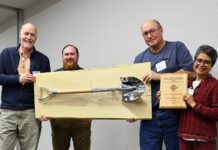I finally got around to putting out the Halloween decorations over the weekend, and I was reminded that’s the fun part. The other part is the cleanup.
The bird bath has got to be scrubbed and stashed away. The lawn ornaments and porch decorations need to be taken down and stored for next summer. And the nest boxes and birdhouses need to be inspected, cleaned up and repaired for next season.
Nest box maintenance
Inspections. While birdhouses can be taken down, cleaned up and stored during winter, fixed nest boxes cannot. Fall is an excellent time to inspect any nest structures that you have and make a note of damaged or rotted material that needs to be repaired or replaced.
Remove debris. After your nest boxes and birdhouses have been inspected, they should be cleared out for next season. This starts with removing any old nesting material and disposing of it away from the nest box to avoid attracting predators. Make sure you can see clearly before reaching inside the nesting box and wear gloves and a face mask to remove debris.
Clear out bee and wasp nests. If bees or wasps have taken over the nest box, remove the nest. You can wait to do this until the temperature drops and they have died. Add a thin layer of non-stick cooking spray or rub an unscented bar of soap onto the inside surface of the roof to create a slippery surface and prevent insects from establishing nests in the future.
Scrape the interior. Once the debris has been removed, scrape the interior of your nest boxes with a stiff brush and unclog drain holes.
Disinfect the interior. There are a few homemade solutions you can make and use in a spray bottle to disinfect the interior of your nest boxes. The first is a bleach solution that’s 10% bleach and 90% water. The second is a vinegar solution — 1 cup of vinegar mixed in a gallon of water. The third is 3 cups of hot water, 3 tablespoons of baking soda and 3 tablespoons of lemon juice. After you spray the interior of the nest box to disinfect it, leave it open to for at least a day to dry out.
Make repairs. Retighten any loose screws or hanging hardware. Replace any damaged or rotted wood. Repair or replace damaged predator guards.
Store for the winter. If your nest boxes can be taken down and taken in, storing them will help reduce the weather they’re exposed to and may add to their longevity. However, they can also be left up as winter roosting sites.
Check again before spring. If you leave your nest boxes up, they need to be checked and potentially cleaned again before spring. Small mammals like mice will move into nest boxes from late fall to the end of winter. Their nests should be removed before songbirds migrate back in the spring. You can discourage other wildlife from nesting in them by leaving the front or side of the nesting box open until spring, however, this can expose them to more weather.
Recommended times to replace nest boxes
January. Owl nest boxes should be repaired and replaced by January. Many species of owls, such as screech owls and barn owls, prefer new wood chips to be added to the bottom of the box before it’s put back. Don’t put sawdust in your nest boxes as it will hold moisture when it gets wet.
February. American kestrel and Eastern bluebird boxes should be repaired and replaced by mid-February.
March. Songbird and Wood duck nest boxes should be repaired and replaced by the first week in March.













